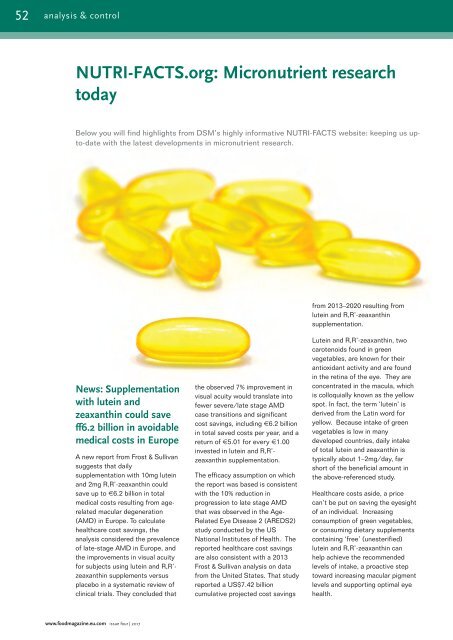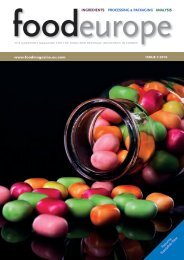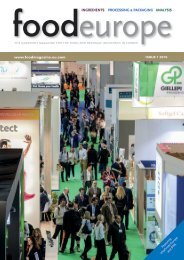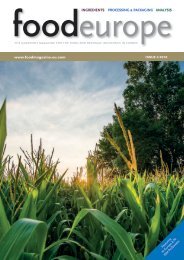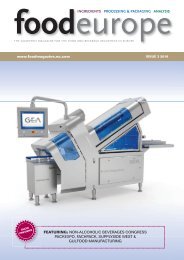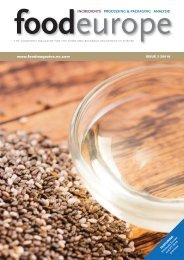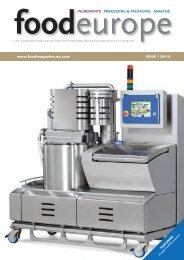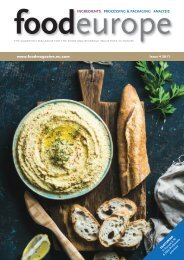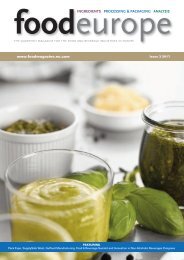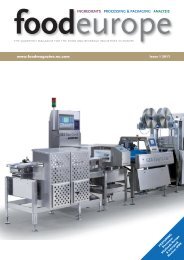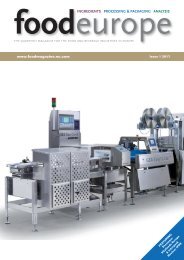Issue_4_2017
You also want an ePaper? Increase the reach of your titles
YUMPU automatically turns print PDFs into web optimized ePapers that Google loves.
52<br />
analysis & control<br />
NUTRI-FACTS.org: Micronutrient research<br />
today<br />
Below you will find highlights from DSM’s highly informative NUTRI-FACTS website: keeping us upto-date<br />
with the latest developments in micronutrient research.<br />
from 2013–2020 resulting from<br />
lutein and R,R’-zeaxanthin<br />
supplementation.<br />
News: Supplementation<br />
with lutein and<br />
zeaxanthin could save<br />
¤6.2 billion in avoidable<br />
medical costs in Europe<br />
A new report from Frost & Sullivan<br />
suggests that daily<br />
supplementation with 10mg lutein<br />
and 2mg R,R’-zeaxanthin could<br />
save up to €6.2 billion in total<br />
medical costs resulting from agerelated<br />
macular degeneration<br />
(AMD) in Europe. To calculate<br />
healthcare cost savings, the<br />
analysis considered the prevalence<br />
of late-stage AMD in Europe, and<br />
the improvements in visual acuity<br />
for subjects using lutein and R,R’-<br />
zeaxanthin supplements versus<br />
placebo in a systematic review of<br />
clinical trials. They concluded that<br />
the observed 7% improvement in<br />
visual acuity would translate into<br />
fewer severe/late stage AMD<br />
case transitions and significant<br />
cost savings, including €6.2 billion<br />
in total saved costs per year, and a<br />
return of €5.01 for every €1.00<br />
invested in lutein and R,R’-<br />
zeaxanthin supplementation.<br />
The efficacy assumption on which<br />
the report was based is consistent<br />
with the 10% reduction in<br />
progression to late stage AMD<br />
that was observed in the Age-<br />
Related Eye Disease 2 (AREDS2)<br />
study conducted by the US<br />
National Institutes of Health. The<br />
reported healthcare cost savings<br />
are also consistent with a 2013<br />
Frost & Sullivan analysis on data<br />
from the United States. That study<br />
reported a US$7.42 billion<br />
cumulative projected cost savings<br />
Lutein and R,R’-zeaxanthin, two<br />
carotenoids found in green<br />
vegetables, are known for their<br />
antioxidant activity and are found<br />
in the retina of the eye. They are<br />
concentrated in the macula, which<br />
is colloquially known as the yellow<br />
spot. In fact, the term ‘lutein’ is<br />
derived from the Latin word for<br />
yellow. Because intake of green<br />
vegetables is low in many<br />
developed countries, daily intake<br />
of total lutein and zeaxanthin is<br />
typically about 1–2mg/day, far<br />
short of the beneficial amount in<br />
the above-referenced study.<br />
Healthcare costs aside, a price<br />
can’t be put on saving the eyesight<br />
of an individual. Increasing<br />
consumption of green vegetables,<br />
or consuming dietary supplements<br />
containing ‘free’ (unesterified)<br />
lutein and R,R’-zeaxanthin can<br />
help achieve the recommended<br />
levels of intake, a proactive step<br />
toward increasing macular pigment<br />
levels and supporting optimal eye<br />
health.<br />
www.foodmagazine.eu.com issue four | <strong>2017</strong>


